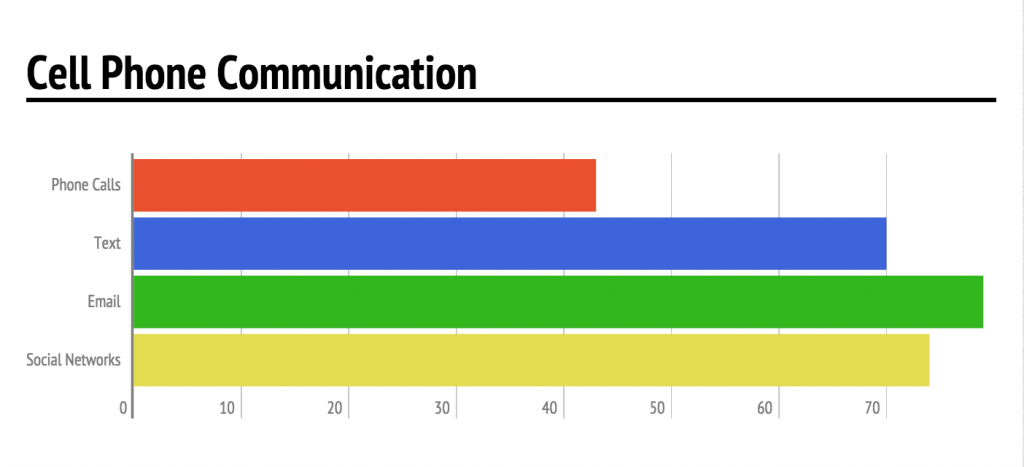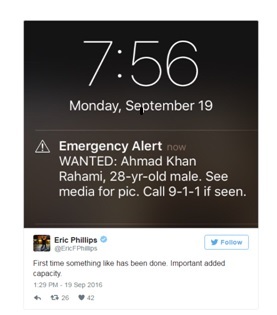The advent of discourses around the ‘smart city’, big data, open data, urban analytics, the introduction of ‘smarter technology’ within cities, the sharing of real-time information, and the emergence of social media platforms has had a number of outcomes on emergency services worldwide. Together they provide opportunities and promises for emergency services regarding efficiency, community engagement and better real-time coordination. Thus, we are seeing a growth in technologically based emergency response. However, such developments are also riddled with broad concerns, ranging from privacy, ethics, reliability, accessibility, staff reluctance and fear.
This post considers one recent technological push for the re-invention of the emergency call system (911bot) and another for the sharing of real-time information during a major event (Smartphone Terror Alert).
911bot
In recent years, there has been a significant move away from voice calls towards texting and internet based platforms (eg.WhatsApp and Twitter)(see figure 1), this is tracked regularly by the International Smartphone Mobility Report conducted across 12 countries by the data tracking company Infomate. In 2015, they found that in America the average time spent on voice calls was 6 minutes as opposed to 26 minutes texting, and worldwide, internet based platforms were the main form of communication (Infomate, 2015 and Shrapshire, 2015).
Figure 1: Cell phone Communication. Source: Russell (2015).
In light of this, there is a push by both the private sector and entrepreneurs to utilise mobile phones and social media platforms in new ways such as within the emergency call system. Within my own field research, I have questioned first responders in Ireland and the US regarding the use of social media and apps as alternative means to the current telephone system. For the most part, this was met with disdain and confusion from first responders. Strong arguments were made against a move away from a call-dominated response system. These included:
a) Difficulty in obtaining relevant and accurate information regarding the event, including changing conditions and situations.
b) Not able to provide the victim or caller with accurate instructions and information.
c) Restrictions in contacting the caller.
d) The system would need an overhaul for it to work, i.e. a dedicated team ensuring that these messages are not missed, and require staff training.
e) Call systems are established mechanisms for contacting the emergency services, why change it when it works?
f) If you use something like Twitter or Facebook to report an emergency how do we ensure that it is reported correctly and not just tweeted or messaged to an interface which is not monitored 24/7?
And as can be seen through the following conversation with two operational first responders in Dublin, Ireland, they want new technology but are also highly hesitant as to its ability to ensure a quick response.
Conversation between researcher and two first responders
R1: See the problem with a tweet and a text, I can’t get any information out of that, like I could tweet and back and then you are waiting for them to send something back, when I have you on the phone, I can question you, “What is it?”, “What is wrong?”, “What is the problem?”.
R2: If you did go with something like [social media platform for emergency call intake], you would have to have the likes of, if you are the tweet man then you would have to be 100% on the phone looking at it
R2: It probably would work if it wasn’t an emergency as such, not a full emergency
R1: I think people need tobe re-assured that someone has seen it and really knows what is happening.
R1: Jesus you could have everyone tweeting saying I have a sore stomach and that would register as a call for us so the calls would just get worse and worse. […] I think if you ring Domino Pizza now, it will know who you are, where you are and your order
R2: They can read the caller ID coming
R1:We haven’t got that
All of these are understandable concerns, but they also illustrate a resistance to innovative change that may result in cultural and institutional change which they oppose due to highly legitimate fears of effectiveness and reliability. Even so, they are welcoming of technology which has obvious benefits for them such as the “Domino’s Pizza” caller ID system, but are more reluctant towards innovations such as the 911bot whose value is overshadowed by fears of inefficiency, information gaps and reliability. However, the 911bot does potentially address some of these issues within its design.
The 911bot (figure 2) was developed during TechCrunch’s Disrupt Hackathon in New York in 2016. It works through Facebook Messenger, which had a reported 1 billion users in July 2016 (Costine, 2016), to allow users to report an emergency. Initially, one would be forgiven for immediately thinking of the arguments made against a transformation of the current system as presented above. However, the messenger app already offers location services based on the phones GPS thus, when reporting an incident, your exact location is immediately sent (although you can turn off your GPS signal and restrict your location being sent, when using this bot there is potential for that to be overridden). The person reporting the incident can also send pictures or videos and the bot can provide information on what you should and shouldn’t do in that situation such as, how to do CPR during a cardiac arrest (Westlake, 2016).
Further, this bot has potential to feedback the location of the first responders to the reporter. It provides the control room with more accurate information coming from real-time videos and pictures meaning that they are not relying wholly on information from untrained and scared people. And, most importantly, this system doesn’t take away from the control room interacting with the caller. From the information provided by the developers, it appears that once the messenger sends the request, the control room calls the phone and resumes their role but with more information. Possibly, going forward this could even be done through Facetime so that the control room has live interaction with the event prior to the arrival of the first responders. Although, the 911bot has only been developed and not deployed, in time and after much consultation and experimentation, it could prove very beneficial within emergency response. For instance, if the control room operator can actually see how the person is conducting CPR, can see and hear their breathing, see the extent of the injury, fire, or road traffic collision in real time, it would inform decision-making that could create better and more efficient responses. However, it would be remiss to discuss this without noting that there are potential privacy issues with the mass use of this type of technology outside of the remit of this post, that would need to be considered.
Figure 2: 911bot. Source: 911bot online.
Smartphone Terror Alert
Another new use of mobile technology was the mass terror alert issued on September 17th 2016, after Chelsea, Manhattan was hit with an explosion. The alert (figure 3) was issued by the Office of Emergency Management, New York Police Department and the FBI through all phone networks. It was received by an unknown number of people and provided information about the key suspect – Ahmed Khan Rahami. The Press secretary for New York Mayor Bill de Blasio stated that it was the first use of this alert at a “mass scale” and as the suspect was caught within 3 hours, it presented the appearance that this alert was effective, with New York’s Police Commissioner stating “it was the future”(Fiegerman, 2016). Yet there is no evidence that the alert had anything to do with the catching of the suspect; these two factors could be circumstantial.
Figure 3: Smart phone terror Alert. Source: published in Fiegerman (2016).
Further, as illustrated by Anil Dash in Fiegerman (2016) how effective was it actually? “Is there evidence that low-information untargeted push notifications help with any kind of crime? Seems they’re more optimised for panic”. This is compounded by the lack of an all-clear alert, which would work to ease tensions and potential panic. We live in a socially constructed risk society (Beck, 1992; 2009) and with innovations such as this, even if the intention is good, the potential for mass panic is created, which raises questions regarding the appropriateness of this mechanism. In this instance, sending an alert with little information, using just a name, makes everyone who could fit that name a potential target, and is an action that could create panic, fear and racial attacks under the illusion of “citizen arrest”. However, this system has potential especially if it were utilised during severe weather events to provide information on evacuation centres and resources rather than during more sensitive events such as a manhunt. Essentially, though, before it can be deemed thoroughly effective and safe there needs to be stringent supportive policy and agency and community training to ensure that response from agencies as well as communities is coordinated and effective rather than panicked and uninformed. So, I wonder, is this really the future, and indeed, does it need to be the future? Is it already the present with no sense of reflection on the potential consequences of such a system by the lead federal and local emergency agencies and institutions? I don’t have the answers to these questions but examining the operational use of this alert even, at its small scale of use, provides opportunities to begin to tease out the danger of a dichotomy between effectiveness and panic and to explore issues around privacy, fear, reliability and usefulness.
In conclusion, this post has provided two different innovations within emergency management, one being experimented with and one which has been implemented. But what is clear is that changes in how we engage with control centres and emergency services are taking place, albeit slowly. But, one can only hope, especially in relation to the alert system, that lobbied criticisms will be engaged with and solutions sought.
Bibliography
911bot (2016) 911bot. [Online]. Available at: http://www.911bot.online/) (Accessed 9th November 2016).
Beck, U., (1992). Risk Society: Towards a New Modernity. London: Sage.
Beck, U., (2009). World of Risk. Cambridge: Polity Press.
Costine, J. (2016) How Facebook Messenger clawed its way to 1 billion users. [Online]. Available at: https://techcrunch.com/2016/07/20/one-billion-messengers/ (Accessed 8th November 2016).
Fiegerman, S.(2016) The story behind the Smartphone Terror Alert in NYC. [Online]. Available at: http://money.cnn.com/2016/09/19/technology/chelsea-explosion-emergency-alert/ (Accessed 9th November 2016).
Infomate (2015) The International Smartphone Mobility Report [Online]. Available for download at: the International Smartphone Mobility Report (Accessed 7th November 2016).
Russell, D. (2015) We just don’t speak anymore. But we’re ‘talking’ more than ever. [Online]. Available at: http://attentiv.com/we-dont-speak/ (Accessed 9th November 2016).
Shropshire, C. (2015) Americans prefer texting to talking, report says. Chicago Tribune [Online]. Available at: http://www.chicagotribune.com/business/ct-americans-texting-00327-biz-20150326-story.html (Accessed 9th November 2016).
Westlake, A. (2016) Finally, there’s a chat bot for calling 911. [Online]. Available at: http://www.slashgear.com/finally-theres-a-chat-bot-for-calling-911-08439211/ (Accessed 7th November 2016).



